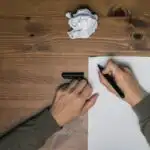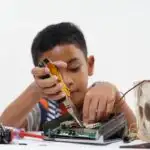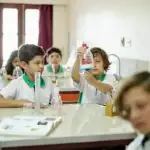Many people must remember how important it is for students to engage with science early in their education.

We shouldn’t only focus on the alphabet, shapes, and numbers. Preschoolers should learn more about science.
After all, it doesn’t have to be extreme. To help you find the best experiments, we have a list of fun science activities for your preschoolers to experiment with.
1. Dissolving Candy Experiment
Preschoolers love candy experiments, and who can blame them? Choose a candy like jelly beans or peeps and leave them in liquid.
Select the peeps and leave them in different liquids, like soda, milk, vinegar, juice, dish soap, or normal water, for 24 hours.
Once you finish waiting, come back and see the results with your students.
2. Straw Rocket
You can teach preschoolers how to make their rockets. Let kids draw their own, or find a template for your students and let them design their rockets.
Give your students two straws each, but ensure each straw has a different diameter. Then, let the kids blow into the straws and watch their rockets fly away.
3. Color Changing Water
Kids need to learn about colors, and one of the best ways to teach them is by using a color-changing water project.
Bring a box of water in, and ensure you have food coloring, glitter, and kitchen items to mix the water.
Your preschoolers will see how the colors mix by adding different measurements to the water.
4. Crystal Making
We recommend teaching your preschoolers how to make their crystals. There are different tutorials available online.
You can make these from borax or encourage your students to make their candy crystals.
Making crystals is easier than it looks, and they can design them however they want with the help of food coloring.
5. Growing Flowers
Do you want to teach your students about the environment but are unsure of the best way to help them understand?
One of the easiest methods to teach students about the ecosystem is by letting them grow their flowers.
All you need is a small pot and some small flowers, and you can show them how they grow by adjusting the environment in which each flower grows.
6. Design Your Own Planet
If you want to teach your students about the solar system, we recommend encouraging them to design their own planets.
Your preschoolers can make their own planets using balloons, paint, construction paper, tape, and glue.
This experiment encourages your students to think about different textures and ecosystems to make their own perfect planet.
7. Saltwater Into Freshwater Experiment
Turning saltwater into freshwater is fun for all ages, but it’s especially popular among preschoolers.
You only need salt, water, a mixing bowl, a small rock, and plastic wrap. It’s a great way to teach your students the difference between saltwater and freshwater and how to filter water.
8. Build A Catapult
A perfect experiment for building motor skills and utilizing their critical thinking is encouraging them to build their catapults.
All you need to do is bring household items, such as popsicle sticks, rubber bands, and a plastic spoon.
Your preschoolers will love catapulting their items across the room, and you can even encourage a little healthy competition too.
9. What Sinks And What Floats?
If you want to teach your preschoolers about buoyancy and gravity, we recommend trying a sink or float experiment.
Ask your students to choose different items and whether they will sink or float. Then, test your theory, and watch as each object remains on the water or sinks to the bottom.
10. Water Dissolving Experiment
Your preschoolers may not fully understand what will dissolve in water or not. If you want to help your students understand the dissolving process, bring in different food items.
Put these food items in separate cups and ask your students if they think they will dissolve or not.
This is a great way to get your students to consider how different chemicals interact with each other from an early age.
11. Shadow Science Experiment
Every child loves to play with shadows; you can find various experiments to show how they work.
You can either engage in a shadow puppet show or get your students to make different shapes themselves if the weather’s great.
If you want to make a shadow puppet show, consider cutting out different animal templates and letting the students pick one they like.
12. Magnet Testing
Consider bringing in some magnetic and non-magnetic objects for your students to experiment with.
Have each student make guesses on what they think is magnetic or not and arrange them in different areas.
You can use this experiment to help your students understand how magnetic objects work and what these items all have in common.
13. Orange Volcanoes
If you want to teach your students about volcanoes, we recommend trying this erupting volcano experiment.
Erupting volcanoes is a childhood staple for many, and you can make it simple using an orange.
All you need is an orange, baking soda, and vinegar. You and your students can then watch and see how the orange reacts to you inserting it with the other materials.
However, bring a bowl to put the orange in, as this can get messy.
14. Growing Grass in Eggs
We admit that this experiment doesn’t require the whole egg, only the eggshells. However, this can be a fun experiment, especially around Easter.
Encourage your preschoolers to design their eggs and draw faces. Then, fill the eggs with soil and grass seeds.
The grass will grow into the hair in the eggshells, so let the students check and help them water their projects.
15. Lava Lamp Experiment
Did you know that lava lamps are easy to make? All you need are simple ingredients; your preschoolers will love watching the chemical reactions.
Get clear vegetable oil, water, Alka-seltzer tablets, and food coloring. Fill your container with two parts oil and one part water, and put in your food coloring.
Then, you just need to add the Alka-seltzer and watch as the liquid fizzes.
16. Make A Skittles Rainbow
Skittles experiments are pretty easy for students to learn, and with the promise of candy, it’s even better for them.
Get your students to make a pattern with their skittles. Then pour a little warm water onto the plate and the skittles.
Your preschoolers will see how the water combines and how they also dissolve off the candy.
17. Magic Milk
Fill a bowl with milk, and add a drop of dish soap or two. Include food coloring in the mix, and your preschoolers will see the colors dance around the bowl.
Using a toothpick, they can see how the colors move as they also adjust the surface tension. It’s a great way to teach your students about chemical reactions by showing them in action.
18. Dancing Raisins
Raisins are popular among all ages, and they’re a fun experiment for your preschoolers. All you need is fresh, clear soda and a packet of raisins.
Pour your soda into a glass, drop your raisins, and wait for them to move.
Some patience is required when you’re working on an experiment like this, and once it starts, you’ll be able to watch the raisins dance around the glass as the bubbles lift them.
19. Solar System Scavenger Hunt
Suppose you want to teach your students about the planets and galaxies we live in. In that case, we recommend arranging a solar system scavenger hunt.
Create models of the planets, or buy one online. Hide the planets around the classroom, and as they find them, create a base made of black construction paper.
Then, as they find the planets, put them in the correct order and explain where each planet is.
20. Marble Run
Using recyclable materials, you and your students can make a marble run. We recommend bringing some cardboard tubes, paper, and flat cardboard pieces to see how they affect the marbles.
When you build them, you can watch how different positions can impact the marble as it travels.
This is a great experiment to teach your students about friction, gravity, and how it impacts movement.
21. Magnetic Slime
Kids love slime, so we can’t ignore a slime experiment. You can work with your students to make their own magnetic slime using three ingredients.
You only need liquid starch, glue, and iron oxide powder. Mix these, and your students will have their own slime to play with.
Best of all, they’ll be curious to understand how the slime is magnetic.
22. Tin Foil Boat Challenge
Building projects are fun for all ages, so consider issuing a challenge to your preschoolers.
Using tin foil and other materials, your students can learn how to make their own boats and see how well they float on water.
Allow them to use clay, bendy straws, and card stock so they can see what impacts their boat’s performance.
23. Plastic Milk
Your preschoolers won’t realize what can happen when you experiment with milk.
You can watch your schoolers turn milk into plastic using a mixture of milk, vinegar, food coloring, and a filter.
Doing this allows them to create different plastic shapes with different molds and templates.
This experiment will teach them about chemical reactions and how they can change the composition of a liquid into a solid.
24. Tower Building
Do you want to teach your preschoolers how to balance objects? If so, you can encourage your students to build a tower of spaghetti and marshmallows.
You can also swap marshmallows for apples to encourage healthier eating. Using spaghetti and treats, you can see how high your students can build their toothpick towers.
25. Water Cycle In A Bottle
Your students must better understand the weather, which is why we have this exciting water cycle in a bottle experiment.
We recommend using a clear plastic bottle, preferably a VOSS bottle, for this experiment.
Fill the bottle with water, food coloring for clarity, and a sharpie to decorate each bottle. Put the water bottle near a window, and watch how the water reacts.
You’ll be able to see the water evaporate, condense, and precipitate, so you can teach them about what happens when it rains.
26. DIY Bouncy Balls
Kids love to play with bouncy balls, so it’s good that we know how to make our own. All you need are the right ingredients and patience.
Using water, glue, borax, cornstarch, and food coloring, your preschoolers can easily make their bouncy balls to play with.
Using these, they’ll also be able to better understand how the chemicals interact with each other to form the ball.
27. Yeast Balloons
Balloons are always part of the best experiments, so consider seeing how balloons blow up using yeast.
All you need are squeezy bottles and three packets of yeast. Using tape, stick the balloons to the bottles containing different types of sugar.
Ideally, we recommend using water balloons for this experiment, as they’re more durable than normal balloons. Then, let your students bet on which balloon will grow the most.
28. Sunscreen Painting
It can be difficult to teach kids how important sunscreen is, especially as they don’t understand the damage the sun can do to your skin.
We suggest grabbing sunscreen and black paper to help your students understand.
Paint a picture with sunscreen, and your preschoolers can see their picture clearly after leaving the paper outside for a few hours.
29. Shaving Cream Rain Clouds
Your students will better understand how rain works with the help of this shaving cream rain cloud experiment.
Fill a container with shaving cream and water, and add droplets of food coloring to show any changes.
As more water saturates your clouds, you’ll be able to see the food coloring droplets fall in the water and spread.
30. Color Changing Flowers
You can show your students how to change the color of different flowers by bringing white roses or carnations into the classroom.
Fill each vase with water, and use plenty of food coloring. Split the stem from the bottom to the top, gently position each stem into each vase.
You can then watch as the stem gradually changes, and they can guess what happens to the flower as it drinks more water.
Your students can gradually see the flower change color, and it will surprise your students to see how the color changes.
Further reading: 1st grade science project ideas
Final Thoughts
We understand how important it is to get preschoolers interested in science from a young age.
However, it can feel like a challenge to find appropriate experiments that they will understand.
With the help of this article, you should have no issues finding the perfect experiment to share with your students.
If you’d like any more inspiration regarding your lessons, feel free to check out the other articles on our site. We’re sure you’ll find plenty of resources at your disposal.
- Homeschooling In High School: Pros And Cons - February 24, 2024
- How Do I Withdraw My Child From School To Homeschool? - February 23, 2024
- How To Not Go Crazy Homeschooling Kids: A Guide For Frazzled Parents - February 22, 2024









Leave a comment